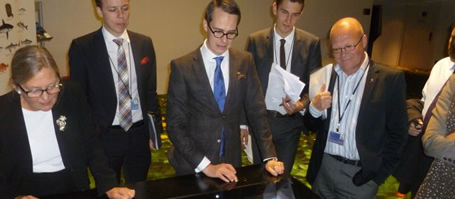Researchers from the Kiel Leibniz Institute for Marine Sciences (IFM-GEOMAR) came to this conclusion in an interdisciplinary study. The study, which took place under the auspices of the Kiel Cluster of Excellence “Future Ocean”, has been published in the current edition of the renowned scientific journal “Geophysical Research Letters”.
Scientists have been warning for several years, that methane hydrates, stored in the sea floor as ice, are melting as a result of global warming. Through this warming the greenhouse gas methane could escape into the atmosphere and further drive climate change. Researchers from the Leibniz Institute for Marine Sciences (IFM-GEOMAR) in Kiel have now quantified the effect of sea currents on sea floor warming in the Arctic and calculated its impact. In their publication in the scientific journal “Geophysical Research Letters” they diffused the warning – conditionally: “Our calculations with various computer models show clearly that the climate in the next hundred years will not be threatened by any additional danger from methane gas release”, summarizes the main author of the study Dr. Arne Biastoch. “The gas hydrates are dissolving with a time delay, so that the consequences will be felt in two to three hundred years – a time frame which doesn’t allow any definitive statements to be made now. We should take these long-term consequences into account in discussions on climate change. But we shouldn’t dramatize the situation”.
The researchers are sounding the alarm, however, with a view to the “other CO2 problem”: ocean acidification. Up to now it has been mainly observed, that ocean water absorbs carbon dioxide (CO2) from the atmosphere. Chemical reactions cause the pH value of the water to decrease. In particular cold water from the northern latitudes, which absorbs an especially high amount of CO2, quickly becomes corrosive. The consequence: corrals, mussels, snails and plankton, can no longer synthesize their calcium shells.
Even a limited amount of methane hydrate melting accelerates this phenomenon. “We calculate that in one hundred years about 12 per cent of the methane deposited in the sea floor will be released”, says the author Prof. Lars Rüpke. “Further we expect that around half of this will be taken up by highly specialized microorganisms on the ground and thus deposited as a solid” adds author Prof. Tina Treude. “However, the rest of the gas could be released directly into the atmosphere or, following microbial decomposition to CO2, could decrease the pH value of the ocean water. The ph value of the Arctic Ocean could decrease thereby twice as fast as expected up to now – and that in the lower water levels.”
It is exactly these levels which biologists and ocean chemists considered up to now the least effected by ocean acidification. “Older studies only focused on CO2 from the atmosphere that was absorbed at the ocean surface. Accordingly it was assumed, that the upper levels would acidify.” says Treude. “For the Arctic we have now proven, that areas near the sea floor are also endangered.”
The ocean currents in the Atlantic are for the most part responsible for the increase in temperature on the sea floor in the Arctic. Although calculations from the Kiel scientists have unearthed great seasonal and decadal variations, an average warming of 2.5 degrees Celsius per century is in the offing. Whereby the temperature increases in the shallower water on the continental shelf will probably be somewhat higher than this, those on the continental slopes at the transition to the deep sea will be somewhat lower.
In their study the Kiel experts for the first time combined models of past and future with calculations on the gas hydrate stability zone (GHSZ), in which gas hydrates develop from methane gas under high pressure at low temperatures. Further analyses should specify their first impressions and explore what other areas of the world’s oceans are affected by sea floor warming. The simulations necessary for this are so extensive, that they can only be carried out on super computers, such as those at the Christian Albrecht University in Kiel.
Original work:
Biastoch, A., T. Treude, L. H. Rüpke, U. Riebesell, C. Roth, E. B. Burwicz, W. Park, C. W. Böning, M. Latif, G. Madec, and K. Wallmann, 2011: Evolution of Arctic Ocean temperatures and the fate of marine gas hydrates under global warming, Geophysical Research Letters, 38, L08602, doi: 10.1029/2011GL047222.
Photographic material:
Pictures can be downloaded at www.ifm-geomar.de/presse
Contact:
Dr. Arne Biastoch, Tel. 0431 – 600 4013,
abiastoch@ifm-geomar.de
Maike Nicolai (Public relations IFM-GEOMAR), Tel.: 0431 600-2807,
mnicolai@ifm-geomar.de
…



